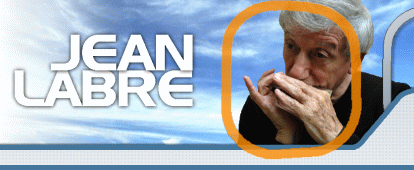Once upon a time Albert Raisner, Biography*
"Albert left us, in the early hours of this new year, at the age of 88. A life of emotions, discoveries and music. A life dedicated to the harmonica, an instrument so close to his heart, his public and his children. We are happy, in his name, of the joy he may have given to those who followed him and of the contribution he may have made to the development of the harmonica, and we thank you, daddy, for the love you gave us.
Your children
Remy and Richard "
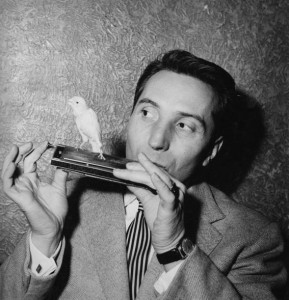 Albert Raisner left us on the first day of 2011, the planet Harmonica is mourning. To tell you about him falls to me and I'll try to do it with the precious help of my memories.
Let's start with our common denominator : the Scouts. We both shared the joys of campfire and music, playing harmonica, long evenings with friends... life good times. One day Albert told me : "... it was the fraternal circle around the campfires that inspired me, much later, the idea of seating the audience in a semi-circle for my TV shows.
And thus, one day I arrived at the harmonica club " Le CHARM ", in Paris, where I was warmly welcomed by Albert himself, and by Robert Deasey, great harmonica player and technical director of this club, of whom the motto was "to chase away the hassles, play the harmonica". By that time I was 17.
I will now recall the personal development of a legend, a man who has been my friend for 63 years.
Albert Raisner, legally named Rufenach, was born September 30,1922, in Apolda, Germany. While attending school and later university with great success, he had begin, since his childhood, to learn music with his father who guided him towards classic. Albert studied violin, piano, clarinet, guitar and bass. But as a child living in Montmartre, he very soon had a fondness for marginal instruments such as the jazzo-flute, kazoo, musical saw and harmonica,of which his father said " this instrument is just good to make goats dance".
Having acquired a solid classical training, he started in the early thirties to study seriously chromatic harmonica in a Scout association " Association Française pour l'Expansion Musicale ", directed by Charles Rodriguez, "Monsieur Ro" (accordionist, violinist, guitarist, band man, philosopher) the first harmonica pioneer in France. Thanks to him, Albert reached a professional level, continually improving by playing in shows in which he took part here and there : " At Pigalle, at around 6:30 p.m., there used to be a musicians market. I was often "bought" for some occasional ball where I was employed in various ways (with a preference for the double bass, because it was the instrument that played the fewest notes and I could lean on it when, at around 3 or 4 o'clock in the morning, fatigue got the better of me!). Sometimes I discreetly took out my chromatic harmonica for a swing or a "valse musette". Surprise and first bravos" he told me later.
Concerning his university cursus, he was crowned with a doctorate in philology. Our eclectic Albert was passionate about foreign languages, he spoke eight of them ! He was German teacher for a few months, but the priority of the musical events compelled him to abandon this course.
His linguistic passion, ease of access to foreign languages enabled him to begin a brilliant international career. He has been rewarded when he was awarded the "Order of Merit Knight". But he did not stop there; he later devoted himself to patronymic philology.
In an other field Albert, always conscious of his figure, was a great sportsman. He has been a university champion in swimming competition (100 meter freestyle) ; he also used to be a regular jogger in the Bois de Boulogne (Paris suburb).
Back to harmonica... We are in 1945, Albert Raisner created the CHARM club in Paris. The idea of an harmonica trio was sticked in his mind, soon he materialized it, approached by Sirio Rossi who was also in quest of an orchestral group.
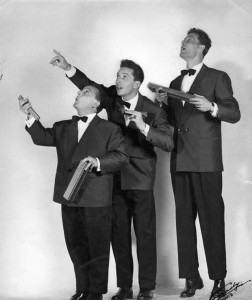
The affair did not drag on : Adrien Belin joined them as bassist. Sirio as an accomplish musician (also great guitarist) alternated chord and solo with Albert. Thus was born the famous Trio Raisner.
Two years later, a dynamic tap dancer Aster Day (André Dionet) succeeded to Albert Belin on bass. The size difference between the three (André measuring 1m51, Sirio 1m90), naturally generated a scenic acting in the pure musical tradition.
At first, they were hired in the "Special Service shows " (a kind of army theatre) for American soldiers. And there, they rubbed elbows with Armstrong, Ella Fitzgerald, Frank Sinatra, Marlène Dietrich, Mickey Rooney, the Max Brothers, etc.
Back in Paris,he moved in Saint Germain des Prés, lively area, with its in vogue cellars (clubs), cultural meeting places where people used to dance be-bop accompanied by famous jazzmen. The trio attended
the "Vieux Colombier" cellar, at that time fief of Sidney Bechet and Claude Luter .
We are in the fifties, the trio was now showing on at the Olympia, Bobino, ABC theatres, "Concerts Pacra", etc... not only in all prestigious concert halls, but also on the radios, as an extensive discographyµµ and many videos that we find nowadays in the internet are showing it.
The trio was involved in several French and German movies. In 1953, it won the prestigious "Grand Prix du Disque" awarded by the Charles Cros Academy.
The CHARM of the Petites Ecuries was becoming a hub for harmonica in Europe. Circumstances were favorable, beginning by the support of Hohner and its directors Jules Coulon and his brother Yves, and counting even more there was Albert's dynamism. All factors which lead on Albert initiative, to the creation of the FIH (Federation Internationale de l'Harmonica) on October 1950 in Trossingen, immediately followed by festvals such as the one at the Salle Pleyel, in Paris, in 1950, and by the World Harmonica Championships.
From that moment the CHARM was to be host, in its premises, of the upper crust of the harmonica planet : Larry Adler, Dany Kane, Borrah Minevitch, Toots Thielmans, Django Reinhardt, Claude Luter, etc. I used to be a regular visitor to these appointments, accompanied by a realistic singer, Gille who became my wife and the mother of my daughters.
In the late fifties a universal tsunami revolutionized the music world : Rock and Roll! Gene Vincent and his "Virginians", Bill Haley and his "Comets », Elvis Presley put us on fire... Albert included. The repertoire of the trio had to move towards a new style, to a Rock attitude, as many videos on internet are showing it. In London, the trio recorded "Rock Around the Clock" and "Don'be Cruel", other trios were doing the same in France. Later on, Hohner was to produce a "Marine Band" bearing the image of the Beatles.
In 1958, Albert realized an incredible challenge : "Le Tour de France de l'Harmonica" which is still spoken in the cottages! A true marathon relayed by the medias including a weekly radio show : "Three men, three Harmonicas".
But the wind was turning, especially since the CHARM rue des Petites Ecuries had disappeared. Hohner was moving and settled Van Loo street in an severe building... without CHARM ! With a sole survivor from the fifties, Helmut Hohner (descendant of the famous family), a genius for harmonica tuning and repairing .
1960, Albert allowed himself a break, a time for reflection during which he presented on France Inter radio " The 1000 Francs Game ". As an astute businessman he had felt that times were changing and that nothing would ever be as it has been afore. After careful consideration he dissolved his trio and turn to match the outbreak of TV.
Building on the success of a radio program "Salut les Copains"(Europe 1, by Daniel Flipacchi) gathering numerous young people, he also relied on youth and set as an objective to undertake the same approach on our good old TV with only one channel, in black an white!
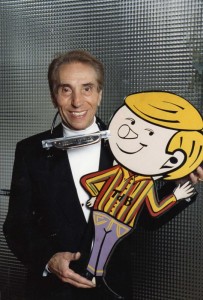
Bet won! With the first issue of " Tender Age and Wood Head ". The tone was given by a young and enthusiastic participation, dancing the Twist on the TV stage ! Albert invented "Wooden Head", escaped from a small puppet animation, to which he lent his voice. With an innate sense of logistics and the ability to adapt himself to all direct TV situations, we may consider that Albert has been the forerunner of TV variety shows in France. The proof is that his show is still in the top 5 of the best TV shows of the past century.
" Tender Age " disappeared in 1966, renamed " Wood Head and Tender Years". This issue disappeared definitively in 1968. Albert played host in others TV shows, like Europarty, Point show in which he received Jimmy Hendriks.
For over a decade, many artists will scroll on the sets of his program, including : Johnny Hallyday, Sylvie Vartan, Dick Rivers, Sheila, Claude François, Jacques Brel, The beach Boys, Michèle Torr, and some more.
13 Juillet 1979, Albert married Brigitte Konjovic, they had two sons, Remy and Richard.
The late eighties and early nineties changed all that, improved communications, the beginning of internet and the concomitant birth of I.H.O. (International Harmonica Organization). I am grateful to Albert for having urged me to join this association, of which I later became Europe vice President.
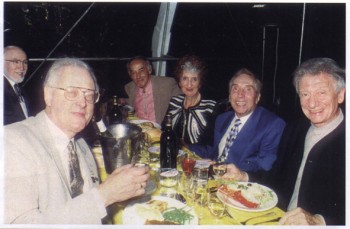
Therefore, I didn't not fail to keep him to date as it was the case during a radio show on "radio Montmartre". Albert has been Honorary President of the International Festival FIH/IHO, October 1999, as evidenced on the photo, appearing from left to right : John Walton (UK), at this time president of I.H.O., Albert founder of the FIH and me.

He also has been an enthusiastic guest of our Autumn rendez-vous Harmo-Beaujo until 2002.
What about the writer ? Further his writings on philology, his
" Book of the Harmonica " (editor : Editions du Temps Passé), is still nowadays our mouth music bible. Other books : "L'aventure Pop" (Editor Laffont), a subject that fascinated him as an outcome of his rock adventure, then his " General Method for Harmonica" (editor Hohner), preface by Darius Milhaud. I won't forget the press man with, in 1960, the output of the magazine " Harmonica Magazine " printed in 20.000 copies, sold on newsstands. He often spoke in " Harmonica, Accordion and Music » magazine, featuring repeatedly on the front cover.
Such a journey deserves to focus on the personality of Albert Raisner, on his qualities : I would like to put first pugnacity associated to a subtle intelligence , allied to a virtuosity to practice lobbying ; our Albert always very spruce, often attracted attention at trade shows and other public events. But in such circumstances people doesn't always become friends ! He did not pay attention to that, ignoring the critics. To summarize, we can say that he was seasoned to overcoming obstacles, subtle like a Stradivarius, powerfull like a Ferrari. An Albert to whom later something extraordinary has arrived : " My harmonica played nothing but lullabies! Between two bottles it has found four extremely attentive little ears : Remy and Richard were given to me like a double sun! " This is where we discover the hidden face of the man.
His health condition was worsening, it was now in his home that I was going to visit him, each time bringing him from Germany klösse, a traditional German course he loved. I saw him for the last time two years ago,he was greatly weakened by the disease, but this didn't prevent us from recalling memories of our Enlightened years...
Our long journey ended at the dawn of January 1, 2011.
God be praised, myths are immortal.
- Jean Labre
Photo: Albert's two sons Remy and Richard with the celebrate singer Michèle Torr
Published February 11th 2011
|
